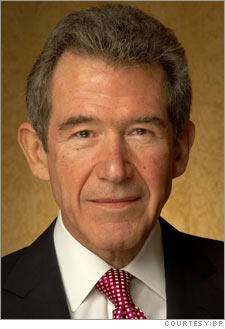|
BP was warned Interviews with employees and a 2002 letter predicting 'catastrophe' show that BP's problems should have come as no surprise to management, Fortune's Nelson Schwartz reports.
NEW YORK (Fortune) -- How could BP, a company that has made being green a core part of its identity, even rebranding itself as "Beyond Petroleum," suffer within one year both the worst oil spill in the history of the North Slope and the worst U.S. refinery accident in more than a decade? And how did CEO John Browne, the energy visionary who publicly broke with his industry to acknowledge a possible link between emissions and global warming, earning a prominent spot in Vanity Fair's recent green issue, become a scapegoat for Big Oil?
(This is an excerpt from a story in the October 16 issue of Fortune. Read the full story.) The answer is clear to some current and former BP (Charts) employees, union reps, and other whistleblowers interviewed by Fortune. Until recently, they say, BP's internal culture was characterized by intense pressure to keep costs down, and budgeting often took precedence over routine maintenance and occasionally over safety. "The catchword we heard was 'managed risk,' " says Kristjan Dye, the leader of the United Steelworkers local at Prudhoe Bay and a 20-year North Slope veteran. "If you pointed out problems, you weren't told to shut up. You could bring it up - but it might not get fixed." Indeed, in a March 2002 letter obtained by Fortune, inspection and quality-assurance specialist Bill Herasymiuk warned superiors in BP's corrosion, inspection, and chemical team of a potential "catastrophe" and complained about "the larger lack of consistency and lack of standardization across the North Slope." Herasymiuk, who still works for BP, has been called to appear before the grand jury in Anchorage. As oil prices recovered over the past few years from their lows in the late 1990s, says Dye, BP did begin to put more money into Prudhoe Bay, but it was too late. "It's unfortunate that as everything got better, things kind of caught up with BP," he says. "The chickens came home to roost." Since the March leak and the subsequent shutdown this summer, much of the controversy has focused on a practice called pigging - sending a device known as a pig through the pipe (old oilfield hands say pigs take their name from the squealing noise they make going down the line) to clean it as well as monitor it for corrosion, cracks, sediment deposits, and other threats that might lead to a leak. Practices vary, but everyone now agrees the low-velocity transit lines that failed should have been pigged more often. On the west side of Prudhoe Bay, they were last cleaned and checked in 1998, while on the eastern side of the field, the last pig was run in 1991. The Trans-Alaska Pipeline, by contrast, is pigged every 14 days. BP did take other measures to keep the pipes running, like adding chemicals to combat corrosion and performing spot checks with ultrasound in places where they expected corrosion to occur. But in the past few years, as Prudhoe Bay's production sank and the velocity inside the pipe slowed, sediment apparently built up. Meanwhile, underneath the sediment, bacteria were eating away at the walls. By the time BP shut down the pipes in August, Barrett testified, more than 70 percent of the wall of the tube had eroded in 12 places. At another 187 spots, wall loss exceeded 50 percent. "We were blindsided by the recent leaks," says Bill Hedges, a plainspoken Englishman who is leading the effort to combat corrosion and get the pipes back in working order. "A lot of people feel devastated. In hindsight, obviously we wish we had been pigging. But the data we had told us we were doing the right thing." One current BP employee who worked at both Prudhoe Bay and in Texas and spoke to Fortune on condition of anonymity says no one should be surprised by what eventually occurred. "The mantra was, Can we cut costs 10 percent?" he recalls. At Texas City even money for painting and external corrosion control was tight - until leaks started appearing. "There was an it-can't-happen-here mentality on the part of middle management," he says. Constant turnover only worsened matters, as new bosses would seek to beat the previous manager's numbers. Nevertheless, this employee says he still believes in BP's green ethos and retains his respect for Browne and other top execs. "The values are real, but they haven't been aligned with our business practices in the field," he says. "A scream at our level is, if anything, a whisper at their level." (This is an excerpt from a story in the October 16 issue of Fortune. Read the full story.) ________________ New BP America president Bob Malone spoke with Fortune's Abrahm Lustgarten about Prudhoe Bay and the company's string of problems. Read the interview. |
|

